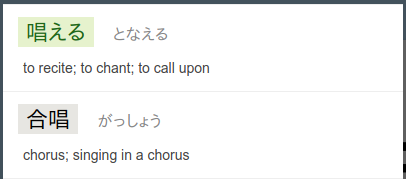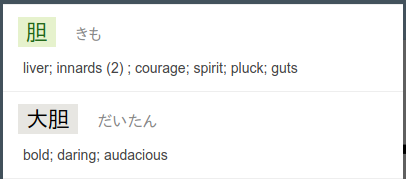Blog / October 2017
-
27 October 2017Soon: Update to the Spaced Repetition Scheduling
(Update: As I wrote in this post there will be custom settings for the SRS so it's possible to keep the scheduling more or less as it is now).
The default review intervals for kanji flashcards will be revised In the next update, which should help ease the review load for long time users.
- There will be 10 piles instead of 7 (not counting the first box which holds restudy and new cards).
- The multiplier used is approx 2.05, leading to :
3 7 13 26 53 109 223 457 936 1919For the first 7 reviews the intervals are a little bit lower than the current values, but otherwise pretty close. - The maximum base interval increases from approx. 8 months to 5 years (~240 days to ~1900 days).
- Keep in mind you can still use "Easy", which further multiplies the interval by 1.5x
I was talking to someone about that. Someone else just brought it up on the forum so I thought I'd confirm this upcoming change and invite you to make suggestions if you like in this thread.
What will happen to my SRS cards?
After the update, answering "Yes" or "Easy" to the cards in the last box will now give them a greater interval. So over time the review load will decrease. and further separate well known cards from newer ones. Existing flashcards are otherwise unaffected. The SRS chart should in theory display just the same, the cards with 7+ reviews will all appear in the last box of the graph.
-
13 October 2017F.A.Q.: How do I reset my flashcards?
I added a new section to the Frequently Asked Questions : "How do I reset my flashcards?"
This is a fairly common question for users who return to the site after taking a medium / long break. If you are going to go through the RTK book again, or some other kanji method and want to add kanji cards back in order this could make sense.
If you just took a long break from reviewing however it's recommended to let the SRS take care of it. Decide how many cards you are going to review per day, say, 30... or how much time (say, 30 mins). Once you have reviewed that amount, end the review with the End button. Trust your memory, even if you stop all your Japanese study for half a year, you may still remember 10 to 20% of the kanji. Those kanji are better off to remain scheduled with a long interval, and you will end up with less reviews over time.
If you prefer to start over, then I recommend to use and abuse the Easy answer. to reduce your review load over time. Keep in mind you can always answer Hard later if you were overconfident, and this will move the kanji card back one box, and to a smaller review interval, so not much harm done.
-
10 October 2017Today's minor updates
The following relatively minor changes went live today:
- Increased the limit for the dictionary lookup results. In most cases it wasn't an issue for for a few of the most common kanji there can be a lot of common words and this caused some of them to simply not appear in the list
- The documentation now includes a section about the Dictionary
- The "Flashcards" menu in the main navigation has been reordered to "Manage Flashcards" > "Flashcard List"
- The forms on Register, Edit Account and Change Password pages have been improved to provide better feedback for validation errors.Hopefully this makes signup a little smoother, especially for non-english users
-
2 October 2017NEW : Highlight entries with known kanji in Dictionary
Today's update adds an interesting feature for users of Koohii flashcards. The dictionary lookup in Study and Flashcard Review pages now highlights vocabulary entries made of known kanji.
Currently a "known kanji" is simply a kanji for which you have added a flashcard. In the future this may be refined based on your feedback. Should a "known kanji" also be reviewed once? Should it include kanji in the failed card pile? Etc.
In this example, a verb made of a single kanji (plus kana suffix) will be highlighted and thus brought to the user's attention. This can provide a good example word to remember the kanji.

In this second example the user has learned the first 50 kanji with the RTK method (index #1 to #50). The second word is not highlighted yet but once the user has learned 大 (kanji #112 "large") then the second word will be highlighted too.

Over the weeks and months as you add more flashcards and your "known kanji" expands, and you revisit the dictionary during flashcard reviews, new entries will be highlighted.
A key point with this approach is that any vocabulary item that is highlighted is always based on previous knowledge.
Do you find this feature useful? How does it fit into your study and how would you like to see it improved? Let me know via contact page or this forum thread.
This feature corresponds to Github issue #125.
By Month
- Mar 2025 (1)
- Nov 2024 (1)
- Sep 2024 (1)
- Jun 2024 (2)
- May 2024 (4)
- Apr 2024 (3)
- Mar 2024 (1)
- Feb 2024 (1)
- Dec 2023 (1)
- Nov 2023 (2)
- Oct 2023 (2)
- Apr 2023 (2)
- Mar 2023 (2)
- Feb 2023 (1)
- Jan 2023 (2)
- Dec 2022 (1)
- Nov 2022 (2)
- Oct 2022 (3)
- Sep 2022 (1)
- May 2022 (4)
- Apr 2022 (1)
- Feb 2022 (2)
- Jan 2022 (2)
- Dec 2021 (4)
- Nov 2021 (2)
- Oct 2021 (2)
- Sep 2021 (2)
- Aug 2021 (1)
- Apr 2021 (2)
- Feb 2021 (3)
- Jan 2021 (3)
- Dec 2020 (1)
- Nov 2020 (1)
- May 2020 (1)
- Apr 2020 (1)
- Jan 2020 (1)
- Oct 2019 (1)
- Sep 2019 (1)
- Aug 2019 (4)
- Jul 2019 (3)
- Jun 2019 (1)
- May 2019 (1)
- Mar 2019 (2)
- Jan 2019 (1)
- Nov 2018 (3)
- Oct 2018 (8)
- Sep 2018 (4)
- Aug 2018 (3)
- Jul 2018 (1)
- Jun 2018 (4)
- May 2018 (1)
- Apr 2018 (1)
- Mar 2018 (1)
- Jan 2018 (1)
- Dec 2017 (6)
- Nov 2017 (4)
- Oct 2017 (4)
- Sep 2017 (5)
- Aug 2017 (5)
- Jun 2017 (3)
- May 2017 (2)
- Apr 2017 (3)
- Mar 2017 (7)
- Feb 2017 (10)
- Jan 2017 (11)
- Dec 2016 (6)
- Nov 2016 (5)
- Oct 2016 (6)
- Sep 2016 (7)
- Aug 2016 (3)
- May 2016 (1)
- Mar 2016 (2)
- Jan 2016 (1)
- Dec 2015 (3)
- Nov 2015 (1)
- Oct 2015 (1)
- Sep 2015 (7)
- Jul 2015 (2)
- Jun 2015 (1)
- May 2015 (5)
- Apr 2015 (4)
- Mar 2015 (5)
- Feb 2015 (4)
- Jan 2015 (5)
- Dec 2014 (4)
- Nov 2014 (3)
- Oct 2014 (2)
- Jun 2014 (1)
- Apr 2014 (2)
- Mar 2014 (4)
- Feb 2014 (3)
- Jan 2014 (4)
- Dec 2013 (2)
- Oct 2013 (1)
- Sep 2013 (1)
- Jun 2013 (4)
- May 2013 (1)
- Mar 2013 (1)
- Jan 2013 (2)
- Oct 2012 (2)
- Aug 2012 (1)
- Jul 2012 (2)
- Jun 2012 (2)
- May 2012 (1)
- Mar 2012 (2)
- May 2011 (1)
- Apr 2011 (4)
- Mar 2011 (3)
- Feb 2011 (2)
- Jan 2011 (2)
- Dec 2010 (8)
- Nov 2010 (8)
- Oct 2010 (3)
- Sep 2010 (3)
- Aug 2010 (1)
- Jul 2010 (2)
- Jun 2010 (5)
- May 2010 (1)
- Apr 2010 (3)
- Mar 2010 (4)
- Feb 2010 (2)
- Jan 2010 (1)
- Dec 2009 (5)
- Nov 2009 (5)
- Oct 2009 (1)
- Aug 2009 (1)
- May 2009 (5)
- Apr 2009 (2)
- Mar 2009 (1)
- Feb 2009 (2)
- Jan 2009 (2)
- Nov 2008 (1)
- Oct 2008 (1)
- Sep 2008 (1)
- May 2008 (2)
- Apr 2008 (1)
- Feb 2008 (6)
- Jan 2008 (5)
- Dec 2007 (6)
- Oct 2007 (1)
- Sep 2007 (2)
- Aug 2007 (3)
- Jun 2007 (1)
- May 2007 (5)
- Apr 2007 (1)
- Mar 2007 (2)
- Feb 2007 (1)
- Jan 2007 (4)
- Dec 2006 (3)
- Aug 2006 (1)
- Jun 2006 (3)
- Apr 2006 (6)
- Mar 2006 (8)
- Feb 2006 (1)
- Jan 2006 (4)
- Nov 2005 (1)
- Oct 2005 (4)
- Sep 2005 (1)
- Aug 2005 (11)
